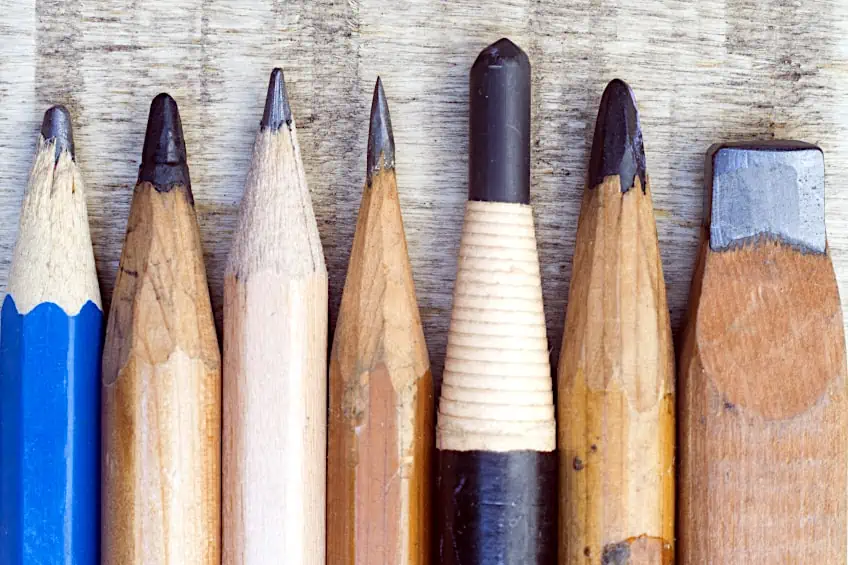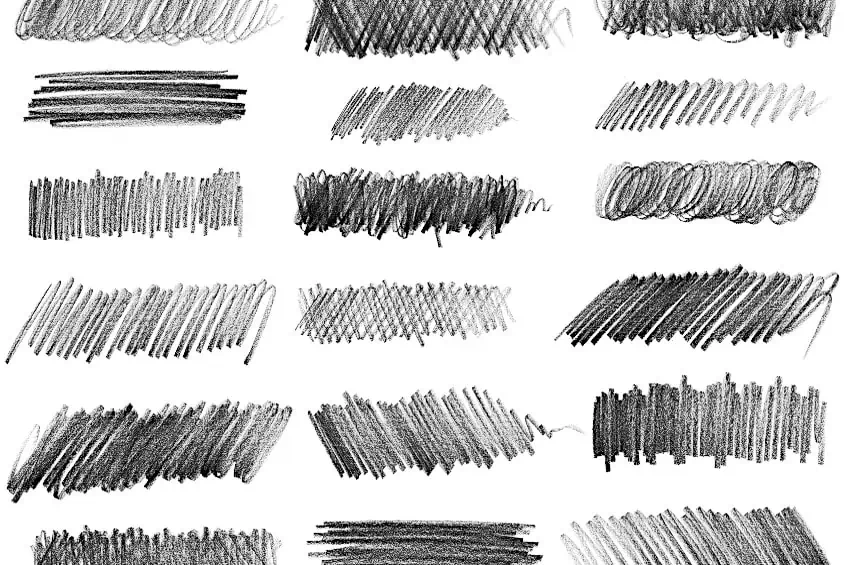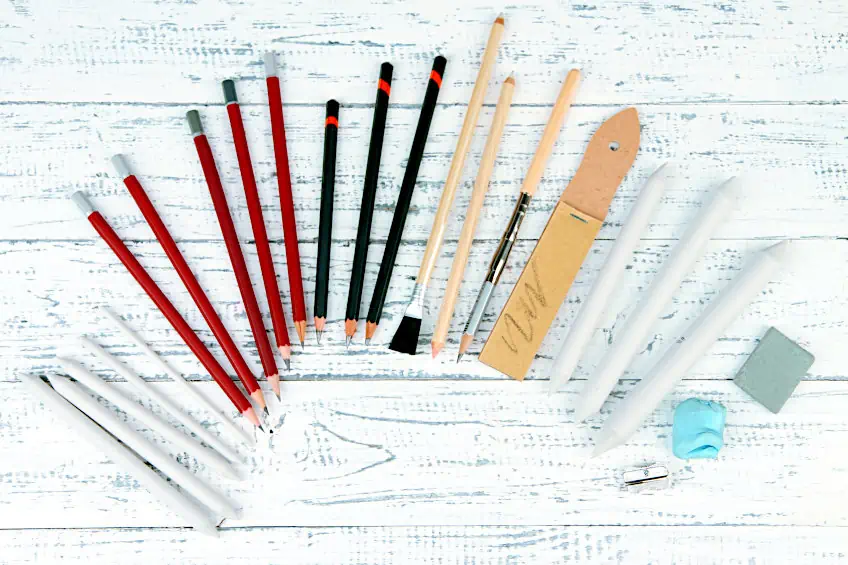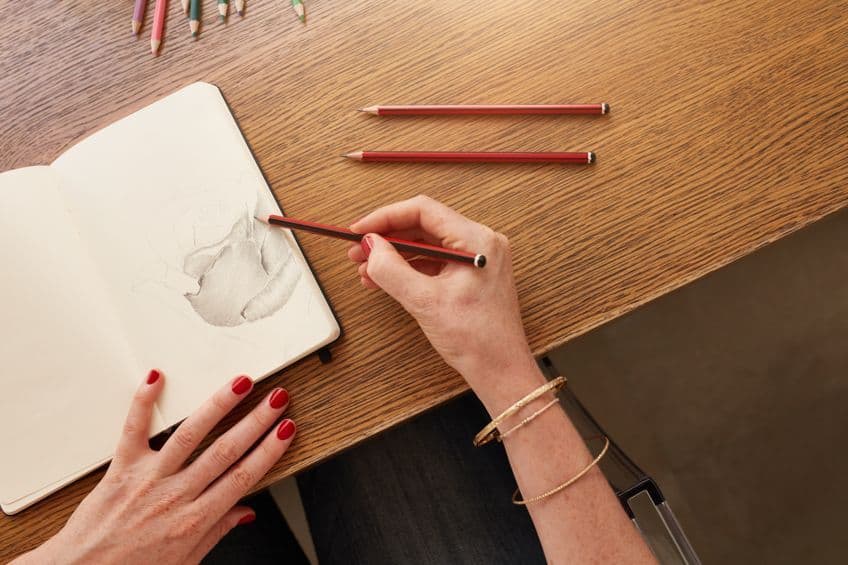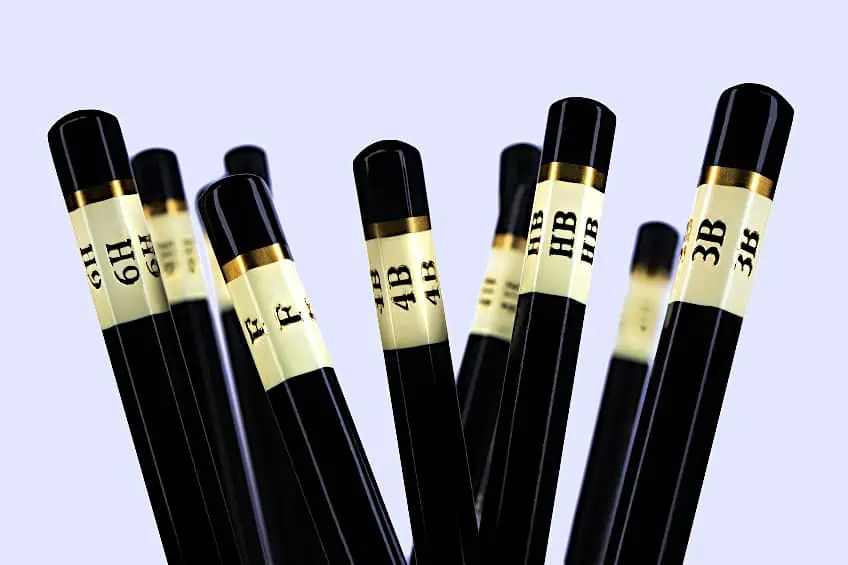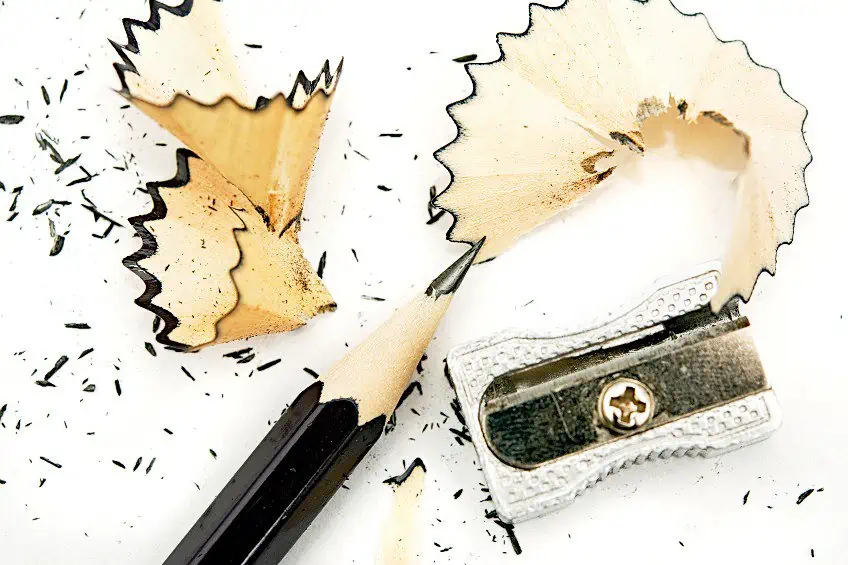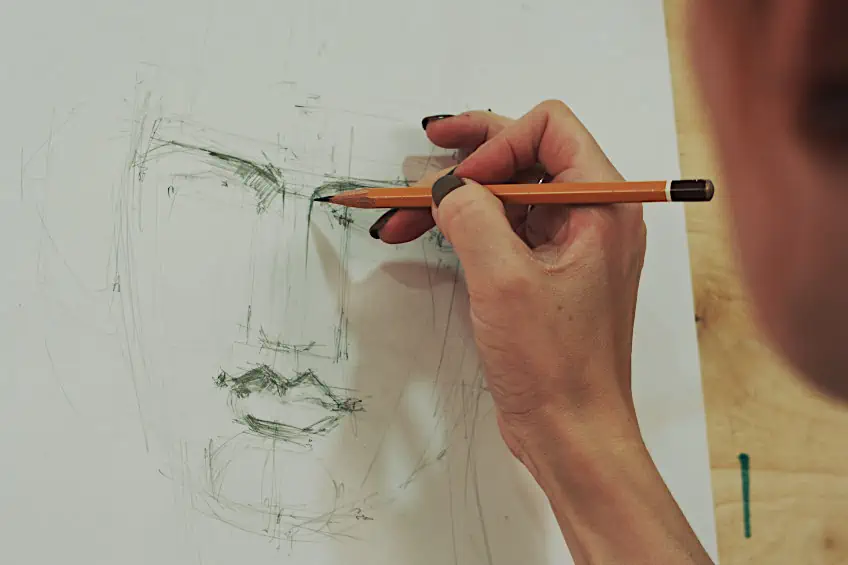Pencil Lead Hardness – A Guide to Choosing the Correct Pencils
Drawing is one of the most beginner-friendly art techniques, as it is both cost-effective and widely available. The large variety of pencils and pencil hardnesses available are what allows you to create pieces that are full of shading and depth without the need for other colors, however, knowing how and when to use these different pencil lead hardnesses can feel overwhelming when you are just starting in the medium. Below, we have put together this comprehensive guide on pencil lead hardness to help you understand and uncover all the possibilities that the pencil medium offers.
Contents
What Is Pencil Lead Hardness?
The hardness of a material is a measure of how resistant its surface is to being scratched or gouged. With this definition in mind, the hardness of pencils is a measure of how much of a pencil’s lead is scratched or shaved off while using it. Pencils contain a core or lead which is made of a mix of graphite, clay, and other filler. The proportions of these compounds in the pencil’s lead are what make the pencil harder or softer. There have been many pencil hardness tests, however, the most widely used is the Wolff-Wilborn test.
This is a simple test where pencils are pushed into a sample and the hardness is determined by the amount of trace material that is left behind.
Why Pencil Lead Hardness Is Important
There is a hardness that will suit the needs of every artist. The right hardness for you can depend on many factors including how heavily you write, the type of paper you are using, and the type of art and art style you are trying to create. If you are heavier handed you might prefer a softer pencil lead to balance it out. The surface of your paper slowly shaves away at your pencil, which is why your newly sharpened pencil slowly becomes dull as you write.
If you are using rough paper, the lead of your pencil shaves off much quicker, which makes your pencil dull faster.
You may, therefore, prefer to use a harder pencil than if you were using a softer or smoother paper. Are you using pencils to create beautiful and intricate artistic drawings, creating clear and precise technical drawings, or merely using them to roughly sketch out a design on canvas before painting? The lead hardness of your pencil will play a large part in how you use them and why.
A Brief History of Pencil Making
The history of the humble pencil begins over 2000 years ago, when ancient scribes from Egypt, Greece, and Rome used a stylus made of lead to record written words onto papyrus. Although we still refer to the core of pencils as its lead, modern pencils are not made of lead at all, but of a form of carbon called graphite. Graphite pencils were first made in Europe in the 16th century and consisted of a stick of graphite wrapped in string or sheepskin. Toward the end of the century, in response to the graphite shortages created by the revolutionary war, the modern pencil lead mixture of graphite and clay was invented. This mixture of graphite and clay is what determines a pencil’s hardness today.
The greater amount of graphite in the pencil the softer it is, while a greater amount of clay results in a harder pencil.
Understanding Pencil Lead Hardness
Broadly speaking there are two primary pencil lead hardness scales, these are the European and American systems. We have created a table comparing both scales as well as what each level of hardness is commonly used for due to their specific properties.
| HB Scale | American Scale | Pencil Hardness | Use |
| 9H – 6H | N/A | Extremely hard | Cartography or lithography |
| 5H – 4H | 4 | Very hard | Tracing or sketching before painting |
| 3H-H | 3 | Hard | Technical drawing, sketching, and writing |
| HB, F | 2 | Medium | Everyday writing and drawing |
| B-2B | 1 | Soft | Freehand drawing and sketches, and writing |
| 3B – 8B | N/A | Very soft | Artistic drawings and studies |
| 8B – 12B | N/A | Extremely soft | Shading large dark areas in drawings |
European Lead Hardness Scale
In the European system, pencils are classified using a combination of numbers and letters. Also known as HB graphite scale, “B” (short for soft black) pencils have softer leads while “H” (hard) indicates that the pencil has a harder lead. The higher the number, the softer or harder the pencil is so if viewing it on a spectrum from softer to harder, then a 6H pencil is harder than a 3H and an 8B pencil is softer than a 4B pencil. “HB” (hard black) sits in the middle of the scale. Japanese manufacturers also use the HB graphite scale, however, instead of HB they have “F” (fine) pencils at the center.
These pencils are similar to HB pencils; however, they tend to be slightly harder and lighter.
American Pencil Lead Hardness Scale
The lesser-used American pencil lead hardness scale uses only a numerical system from one to four. The higher the number on this scale, the harder the lead. A #1 pencil has a very soft lead similar to a 2B pencil. #2 is a soft pencil that closely resembles an HB pencil. The #2.5 pencil lies in the middle of the scale and has a medium soft lead. #3 is a hard pencil similar to a 2H. Lastly, #4 is a very hard pencil like a 4H. This system is less comprehensive and specific than the HB scale, which is why many American manufacturers tend to use the HB scale for their artist pencils.
Even with these classifications, there is no official industry standard for pencil hardness.
Because of this, an HB pencil can vary in hardness across different brands, however, the difference tends to be minimal. Japanese pencils use the same system as European producers; however, they tend to be darker and softer than their European equivalents. We will be using the European pencil hardness scale for the rest of the article as it is more extensive than the American scale.
The Science Behind Pencil Lead Hardness
As we have mentioned earlier, the proportions of graphite and clay within the lead are what determine the hardness of pencils. Hard leads are more compacted and contain more clay filler or other specific waxes and resins. They can be made up of as little as 20 percent graphite, meaning that not much can be released when the pencil is used. This gives them a hard tip that makes fine light lines.
On the other hand, soft pencil leads are not as compacted and contain much more graphite with very soft leads comprising around 90 percent.
These pencils also contain almost no wax, making them softer and darker than hard pencils. Soft pencils transfer more easily than hard leads even with the same pressure. In the European system, B would indicate a softer pencil that has a higher graphite content, whereas H is indicative of a harder lead with a higher clay content.
A Note on Pencil Lead Quality
Just like the hardness, the quality of the graphite used in your pencil lead can also impact your drawing and writing. Leads that are low quality are often not as finely ground as higher quality leads or contain other impurities that can give your pencil a rough, coarse feeling as you write. This may even scuff or gouge the surface of your paper or canvas, which is almost impossible to erase or cover up completely. High-quality pencil leads use pure graphite, which is finely ground and applies smoothly to your surface irrespective of the hardness of the pencil.
These pencils also have a more pronounced difference between their hardnesses as they contain much fewer fillers than lower-quality leads.
Advantages and Disadvantages of Different Pencil Hardnesses
Your pencil lead types affect many aspects of your pencil, including its smoothness, pigmentation, and smudge resistance. There are pros and cons to using both soft and hard pencil leads as well as everything in between.
Medium Pencils
The easiest place to start is in the center of the scale with HB and F pencils. These pencils have a close to equal mixture of clay and graphite, meaning they are neither too hard nor too soft. Medium pencils are great for everyday writing and basic drawing as they have good pigmentation that is dark enough to be easily read but also have minimal smudging.
Soft Pencils
Moving from HB to B leads results in a softer, smoother, and darker line. Higher numbers mean softer leads, and these can go all the way up to 12B on the lead hardness scale. Soft pencils can get very dark but not as dark or soft as charcoal. B pencil lead types can produce quick, heavy lines that go on like butter with much less pressure than hard pencils. This means that you are unlikely to damage your page, but the lead needs to be sharpened more often as it dulls quickly.
Very soft pencils are prone to smudging, which makes them easier to blend and erase but difficult to use if you are left-handed.
Hard Pencils
Moving in the other direction from HB to H, the extra clay and wax increases the density of the lead making them transfer less, resulting in a light fine line. Like with soft pencils, a higher number means a harder lead, however, these pencils only go up to 9H. If you want to make darker lines with a hard pencil you will have to press quite hard, but the line will never be as dark as can be achieved with soft leads, and too much pressure will likely cause unsightly indents or scratches in your page particularly with very hard pencils.
Hard pencils stay sharpened for much longer than soft pencils, however, they are also much more difficult to erase.
This makes hard pencils very smudge resistant, which is great for left-handed individuals. This also means they produce clean and clear lines that make them perfect for outlines, technical drawings, and light sketches especially and under watercolors and other paints.
Choosing the Right Pencil Lead Hardness for Your Needs
There are many factors to consider when choosing a pencil hardness, however, the main thing that determines which pencil you use will be the task you are using it for and the style you are trying to achieve.
Artistic Pencils
Graphite pencils from 3B to 8B on the lead hardness scale provide the perfect drawing pencil scale. These pencils are very soft and black allowing you to easily add shadows and contrast. B pencils offer artists more versatility. Through dark lines and smudges, you can accomplish a wide array of shading that adds depth to your drawings and by adjusting your pressure, you can achieve light lines as well.
While H pencils can create light lines they cannot produce darker ones, and using too much pressure can easily damage the page.
Writing Pencils
As we mentioned earlier, HB and F pencils are the preferred pencils for everyday writing and drawing. B or H pencils can also be great to use depending on how much pressure you use when writing. If you tend to have a lighter hand then you can use a softer pencil to achieve the same effect as an HB pencil, however, it is not recommended to go softer than a 2B pencil because smudging is more notable.
Technical Drawing and Sketching
Pencils from 2H to 6H on the lead hardness scale are the best for technical drawing but are also great for preliminary sketches under paintings on canvas or paper. What pencil is best for sketching depends on what medium you will be using with it. If you are using thicker paints then 3H or 4H pencils are fine, however, for colored pencils or thin paints such as watercolors you will need to use 5H or 6H pencils so that the trace does not shine through.
Other Things To Consider
There are many other factors to consider aside from the task itself. Your finished piece can be affected by things such as the type of paper or canvas you use as well as how you layer your different pencils. Understanding these influences can allow you to turn it to your advantage making the drawing process easier and more rewarding.
Your Paper or Canvas
The paper or canvas you are using is another factor to consider when choosing a pencil hardness. A more toothy or rougher paper will give you a better writing experience overall when compared to a smoother paper, irrespective of the hardness of your pencil. This is especially true for harder pencils, which may have a difficult time being transferred to smoother papers.
Graphite Shine
Another aspect to consider is something called graphite shine. If you have ever shaded with your pencil, you will notice that graphite has a natural shine. Softer pencils tend to produce more shine and can detract from your drawings. This effect can be reduced by layering the soft, darker pencils over the fine light ones using even and steady pressure.
Take care not to smooth the tooth of your paper as this can increase the shininess.
There are a multitude of pencil lead hardnesses available, which makes pencils a highly versatile medium. Whether you are using a softer pencil to create intricate artworks or harder pencils for detailed technical drawings and quick sketches, the best way to discover which pencil hardness is best for you is, undoubtedly, through experimentation. We hope this guide provides the perfect starting point for you to discover the benefits of using different pencil harnesses!
Frequently Asked Questions
What Is the Pencil Lead Hardness Scale?
The pencil hardness scale is a measure of how hard or soft the lead of your pencil is. The European and American scales are the two most popular hardness scales. The European scale uses B to indicate a softer lead and H to indicate a harder lead across a spectrum. There is also a number that indicates the degree of softness or hardness, with higher numbers indicating a greater degree of softness or hardness. A 6B pencil is softer than a 3B pencil, and a 6H pencil is harder than a 3H pencil. The HB pencil sits in the middle of the European scale and has a medium hardness. The American scale is not as widely used as it is less comprehensive than the European scale. The American scale rates hardness on a scale from one to four, with one being the softest and four being the hardest.
What Pencil Is Best for Sketching?
Pencils from 2H to 6H on the drawing pencil scale are the best pencils for sketching onto paper or canvas. Hard pencils are lighter and more precise than soft pencils, which means that they are easily hidden by a coat of paint. Use a 2H pencil to sketch under thicker paints, and a 4H or 6H pencil to sketch under colored pencils or watercolor paints.
What Is the Difference Between an HB and F Pencil?
HB and F pencils are both medium hardness pencils, however, HB pencils are slightly darker and softer than F pencils. HB pencils are in the middle of the scale in the European scale. Japanese pencil manufacturers use F pencils in the middle of their scale instead of HB.
Jordan Anthony is a Cape Town-based film photographer, curator, and arts writer. She holds a Bachelor of Art in Fine Arts from the University of the Witwatersrand, Johannesburg, where she explored themes like healing, identity, dreams, and intuitive creation in her Contemporary art practice. Jordan has collaborated with various local art institutions, including the KZNSA Gallery in Durban, the Turbine Art Fair, and the Wits Art Museum. Her photography focuses on abstract color manipulations, portraiture, candid shots, and urban landscapes. She’s intrigued by philosophy, memory, and esotericism, drawing inspiration from Surrealism, Fluxus, and ancient civilizations, as well as childhood influences and found objects. Jordan is working for artfilemagazine since 2022 and writes blog posts about art history and photography.
Learn more about Jordan Anthony and about us.
Cite this Article
Jordan, Anthony, “Pencil Lead Hardness – A Guide to Choosing the Correct Pencils.” artfilemagazine – Your Online Art Source. December 1, 2023. URL: https://artfilemagazine.com/pencil-lead-hardness/
Anthony, J. (2023, 1 December). Pencil Lead Hardness – A Guide to Choosing the Correct Pencils. artfilemagazine – Your Online Art Source. https://artfilemagazine.com/pencil-lead-hardness/
Anthony, Jordan. “Pencil Lead Hardness – A Guide to Choosing the Correct Pencils.” artfilemagazine – Your Online Art Source, December 1, 2023. https://artfilemagazine.com/pencil-lead-hardness/.


